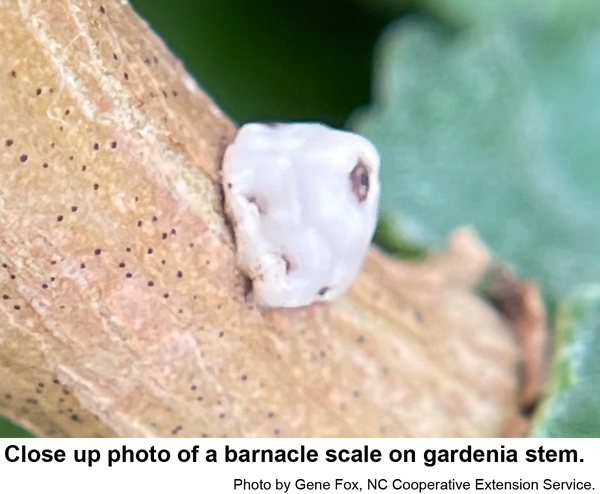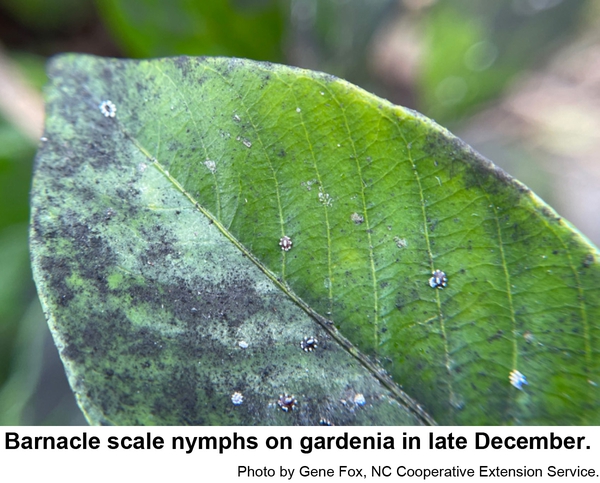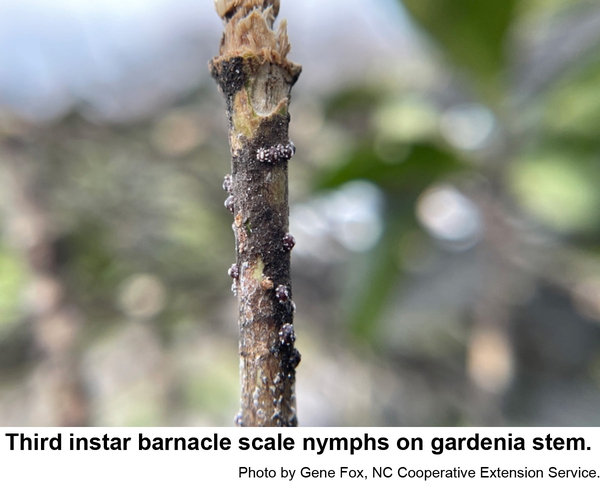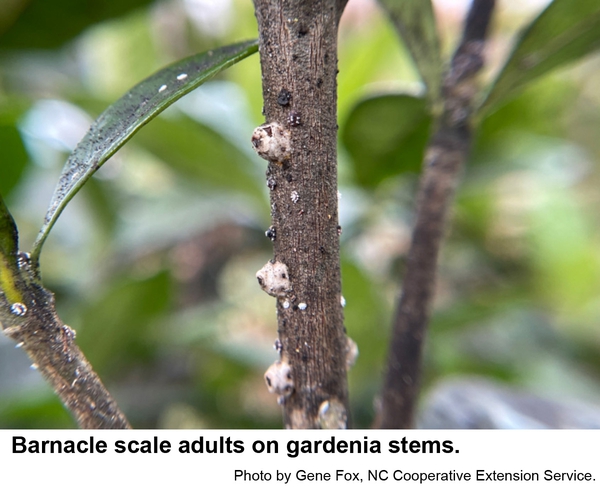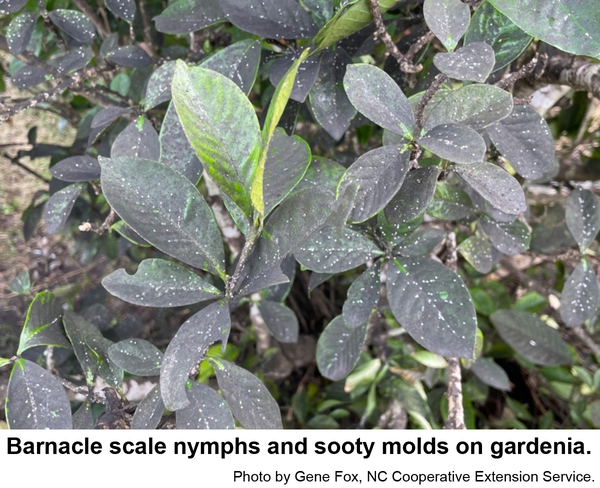Description and Biology
Barnacle scales, Ceroplastes cirripediformis, are reddish brown to brown but are completely covered with a thick layer (test) of pearly-gray wax. Wax and all, they are about ¼ inch long. Depressed lines divide the wax into top, front, and side plates. Each plate has a small, darker, spot usually surrounding a tiny button of wax. A large rear plate has three buttons. Nymphs are partially or nearly covered with a pattern of pure white conical wax plates that show up later as buttons on mature females. Males are rare. No description of males is readily available, but they are likely to be tiny, gnat-like adults.
It is reported that barnacle scale adults are present from late July through winter on stems and twigs. First and second stage nymphs usually occur on the upper side of leaves often lining up along the veins. Third instar nymphs move to twigs where they mature into females and lay eggs beneath their body. However, their biology may not be that precisely synchronized, as nymphs have been photographed on leaves and stems well into early winter. Scales in this genus typically have one generation per year.
Host Plants
Barnacle scales have been recorded from Cannabis, citrus, gardenia, guava, passion flower and numerous other plants in 119 genera in 63 families. In North Carolina, gardenia is the most common host. Infested plants sometimes turn almost black with sooty molds and plant growth is stunted.
Residential Recommendations
Barnacle scale crawlers probably emerge in late May to early June and migrate to the tops of leaves where they are susceptible to an insecticide spray. Young third nymphs that have not completely secreted their waxy covering are also susceptible. After these scales have completely covered their bodies with wax (probably early summer), they are likely to be very difficult to control with sprays. We have found that Indian wax scale immatures are highly susceptible to Sevin insecticide sprays as well as pyrethroid sprays. This is likely the case with barnacle scales, too. Sevin and pyrethroids labeled for residential landscape use are readily available in most big box stores, plant centers, and nurseries. Active ingredients of any pesticide are listed on the front label of any pesticide package by law—usually in very small font near the bottom of the label. The active ingredients of pyrethroid insecticides all end with "-thrin." When used as directed, pyrethroids are very toxic to insects but are not particularly hazardous to humans and pets (other than fish—avoid using pyrethroids around pools, ponds, and streams).
Eliminating the barnacle scales is the first step in reducing sooty molds on infested shrubs. Horticultural oils have the advantage of helping to loosen sooty molds from the plant surface.
Other Resources
- Horticultural Oils for Ornamental Plants. Frank, S. et al. 2018. Entomology Insect Notes, NC State Extension Publications.
- Potential Distributions of the Invasive Barnacle Scale Ceroplastes cirripediformis (Hemiptera: Coccidae) Under Climate Change and Implications for Its Management. Wang, F. et al. 2021. Journal of Economic Entomology 114 (1): 82–89.
- Sooty Molds. Frank, S. et al. 2002. Entomology Insect Notes, NC State Extension Publications.
- The Scale Insects of California, Part 1, The Soft Scales (Homoptera: Coccoidea: Coccidae). Gill, R. J. 1988. California Dept. Food and Agr. 142 pp.
- The Soft Scale Insects of Florida, Homoptera: Coccoidea: Coccidae). Hamon, A. B. and M. L. Williams. 1984. Florida Dept. Agr. & Consumer Serv., Div. Plant Industry. Contribution 600.
- Wax scales—Ceroplastes spp. Anonymous. 2017. How to Manage Pests, Pests in Gardens and Landscapes. UC IPM.
NC State Extension Plant Pathology Factsheets
NC State Horticultural Science Publications
North Carolina Agricultural Chemicals Manual
For assistance with a specific problem, contact your local Cooperative Extension Center.
This factsheet has not been peer reviewed.
Publication date: Jan. 7, 2022
Recommendations for the use of agricultural chemicals are included in this publication as a convenience to the reader. The use of brand names and any mention or listing of commercial products or services in this publication does not imply endorsement by NC State University or N.C. A&T State University nor discrimination against similar products or services not mentioned. Individuals who use agricultural chemicals are responsible for ensuring that the intended use complies with current regulations and conforms to the product label. Be sure to obtain current information about usage regulations and examine a current product label before applying any chemical. For assistance, contact your local N.C. Cooperative Extension county center.
N.C. Cooperative Extension prohibits discrimination and harassment regardless of age, color, disability, family and marital status, gender identity, national origin, political beliefs, race, religion, sex (including pregnancy), sexual orientation and veteran status.

